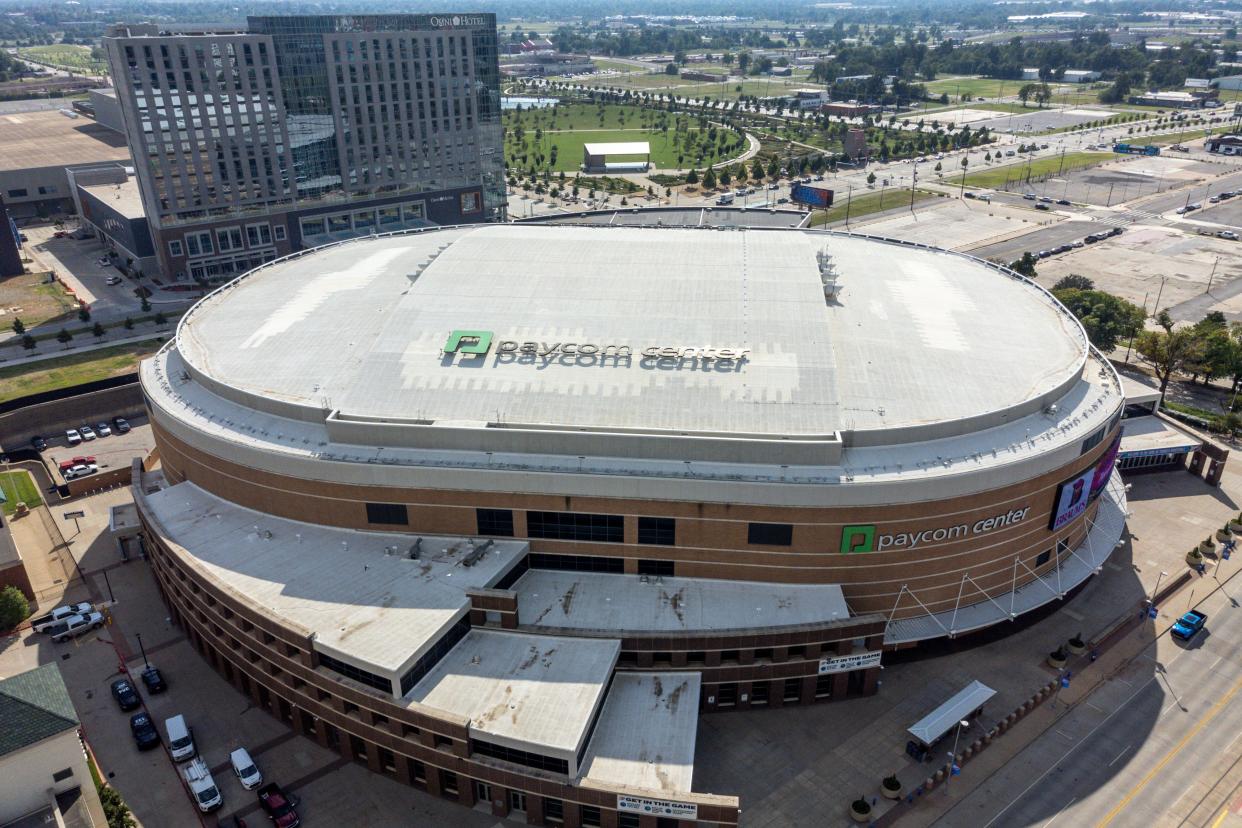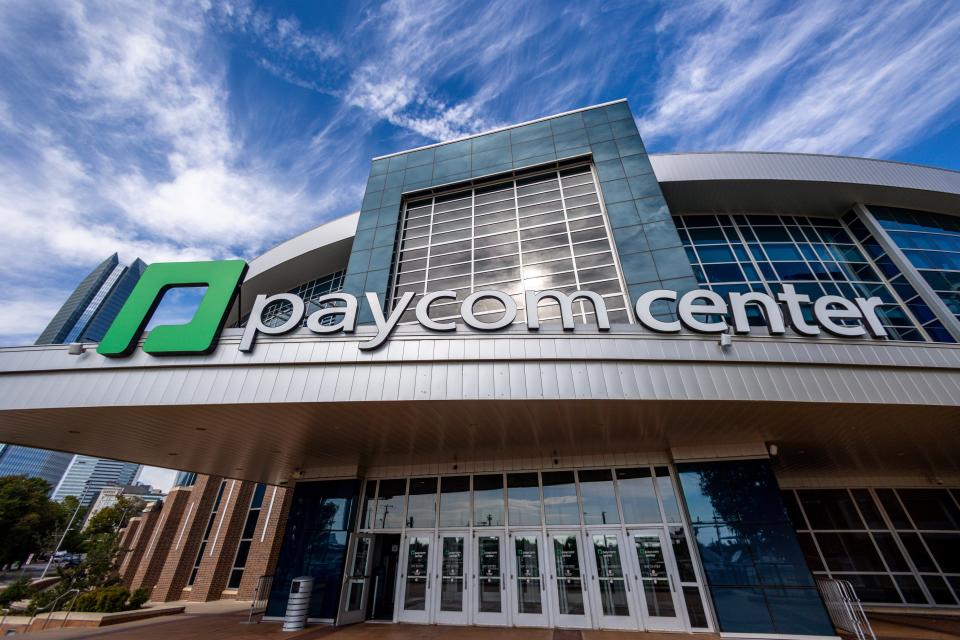Paycom Center's history reflects a changed city, and hints at what might be ahead with a new arena

- Oops!Something went wrong.Please try again later.
- Oops!Something went wrong.Please try again later.
- Oops!Something went wrong.Please try again later.
- Oops!Something went wrong.Please try again later.
- Oops!Something went wrong.Please try again later.
- Oops!Something went wrong.Please try again later.
Paycom Center is not the sexiest arena in the NBA. The home of the Thunder was designed without any anticipation that it might host an NBA team. It was a bare bones venue lacking any of the frills found at other arenas being built at the turn of the century.
But the arena changed Oklahoma City and its skyline. Its legacy hints at what might happen should voters choose Tuesday to build a new arena. And it's a reminder of just how much has changed since the arena was part of the first MAPS election that took place 30 years ago Thursday.
Of the nine projects that were promised as part of the original MAPS, the arena came closest to not even getting built. What voters are set to decide Tuesday is whether to replace Paycom Center with a venue with an entirely different vision.
Imagine an architectural jewel with comfortable seating, better sight lines, restaurants and retail, along with entertainment options that go beyond what happens on the concourses and plazas outside of the arena. Imagine power outlets in every chair, similar to what is included at the new Los Angeles Clippers arena.
Paycom Center opened in 2002 lacking much of what is expected in an NBA arena, and millions spent on upgrades still don’t change the origin story. Paycom Center opened as a Chevy when other cities, including Dallas, were building Cadillacs. The stark design difference can even be seen in Tulsa, which built its BOK Center in 2008 without a major league tenant.
It’s easy to call out the building’s shortfalls, yet its impact on the city and its skyline can’t be denied. And its legacy hints at what is possible with a new arena.
More: Oklahoma City’s NBA arena vote is Dec. 12. What you need to know before you vote.
Paycom Center opened with low expectations
Oklahoma City was very different from what it is today. College graduates were routinely choosing to live anywhere but here. A decade-long oil bust left engineers trying to get by doing janitorial jobs. Empty abandoned homes started popping up throughout the urban core.
Paseo, now a hot spot with expensive homes, was filled with boarded-up houses and empty storefronts. A city councilman declared “downtown is dead and we helped kill it.” This was not hyperbole. Downtown was home to just one hotel, the Sheraton, and just one attraction, the Myriad Botanical Gardens.
The Myriad Convention Center was really just a 13,500-seat arena opened in 1971. It had no restaurants and no suites. The Myriad did come with a leaking roof and a design that was flawed from the start. It was home to two minor league teams, the Blazers and the Cavalry.
The Cavalry brought basketball to the city for the first time in 1990 but folded up in 1997 just as planning for the new MAPS arena (Paycom Center) was getting started. The Blazers, meanwhile, were drawing good crowds, and so it was understandable that city leaders chose to design an arena with the hope of someday landing an NHL team.
Editorial: Why we support building a new arena in Oklahoma City
Sure, they said, it could be adapted for an NBA team. But nobody seriously thought the city was ever going to be in the hunt for an NBA team. And despite the Blazers’ success, the odds seemed to be against the city landing an NHL team after a group led by Clay Bennett tried and failed to land an expansion team.
MAPS, meanwhile, was on the verge of becoming a tainted brand, repeatedly criticized as being over budget and behind schedule. The city council held a straw vote, and all but one supported the idea of shelving the arena altogether to keep the rest of the projects funded and within budget.
The odds against building the arena only got worse when then-Mayor Ron Norick, the popular father of MAPS, decided not to run for reelection in 1998.
All but one of the candidates running to succeed Norick agreed the arena wasn’t really needed, that it should be shelved. The one candidate insisting on getting the arena built, Kirk Humphreys, was also the one City Hall outsider. He won against better known candidates and then convinced voters to support extending the MAPS sales tax by six months to “Fix MAPS Right.”
The rest of this story is well told. Voters agreed to extend the tax. A river that was an embarrassment was transformed into a recreational center for the city that soon will include a $400 million resort. The Bricktown Canal is one of the city’s top tourist attractions. The Civic Center Music Hall is truly a performing arts venue representative of a major league city.
We kept the minor league baseball team by building a stadium that is still among the finest in the country. We got a great new downtown library and sparked an ongoing transformation of the OKC Fairgrounds.
The bare bones arena opened in 2002. The NBA's Hornets, displaced when Hurricane Katrina devastated New Orleans in 2005, played a season at what was then known as “Ford Center.” The arena was successfully drawing concert crowds and had just enough infrastructure to temporarily host an NBA team.
The sold-out games gave the city a chance to prove to the NBA it was ready to enter the major leagues. Bennett led a team of investors in buying the Seattle SuperSonics, and when the city didn’t agree to build an arena, he moved the team to Oklahoma City. Fans weren’t just treated to seeing legends like Kobe Bryant and LeBron James playing at the arena; they also got to see Kevin Durant, Russell Westbrook, Paul George and Chris Paul wearing Thunder gear at NBA All-Star festivities.
The MAPS brand that was launched 30 years ago, once dismissed as tarnished, has carried the city through successive initiatives that have transformed every corner of the city. A downtown that was once declared dead is home to dozens of restaurants, bars and shops, movie theaters, museums, entertainment venues, thousands of new residences, and 20 hotels.
Paycom Center still a bargain
I recently added up the original cost with improvements, expansions done in ensuing years with the Thunder, and Paycom Center ends up still being one heck of a deal, with it hitting about $250 million. That's well below the cost of American Airlines Center in Dallas and other arenas built at the turn of the century.
Oklahoma City got a steal with Paycom Center from the very start. Flintco, which built the arena, made a math error in its bid and yet stuck to it, keeping the total cost to $89.2 million. With the arrival of the Thunder, voters in 2008 approved a temporary sales tax that raised $87 million to pay for league-required arena upgrades and $16 million for a team practice facility.
More than just Thunder: Could a new NBA arena redefine the concert scene in OKC?
Voters again approved another $9 million in 2017 for roof repairs and upgrades not completed when the 2008 sales tax raised $20 million less than what was projected due to the 2009 national recession.
The MAPS 4 election, meanwhile, initially included $116 million for more arena upgrades, but that figure was cut with the hope the remaining $70 million can be used toward the proposed new arena.

The city recently completed the remaining MAPS 4 funded improvements at Paycom Center, which included new seats, elevator and scoreboard upgrades, and NBA-required changes to door heights and media cabling. The improvements ended up costing less than anticipated, and as a result, the amount of MAPS 4 funding that could be used for the new arena could go as high as $79 million.
To date, the total spent on Paycom Center adds up to $222.2 million — still far below the $420 million spent on American Airlines Center in Dallas, which opened one year before Paycom Center.
Dallas paid more, but also got the better arena. American Airlines Center seats 19,200 for basketball games, compared to 18,203 at Paycom Center. The 840,000-square-foot Dallas arena features 120 suites compared to 84 suites at Paycom Center. American Airlines Center also is part of a larger development that includes a large plaza, offices and retail.
The same model has been repeated, and expanded upon, throughout the country. Big league cities are no longer just building arenas — they are creating exciting places with a mix of attractions.
Skyline changes certain with possible new arena
Should Oklahoma City voters approve funding for a new arena on Tuesday, they will trigger more changes to the downtown skyline that will go far beyond a sexier architectural landmark for the downtown skyline.
Mayor David Holt and others at City Hall are being coy when they are asked about where the new arena might be built. The former Cox Convention Center, now home to Prairie Surf Studios, remains the likely spot.
The building was poorly designed and built, and it will require millions be spent on the roof and other infrastructure needs to keep it standing. The block itself is larger than the current Paycom Center site and shares proximity to hotels, restaurants, parking and Scissortail Park.
An arena at Broadway and Sheridan avenues would then trigger development of a permanent home for Prairie Surf Studios.
I’m betting on a studio move to either the old cotton oil mill property south of Lower Bricktown or in Strawberry Fields west of Scissortail Park. These two possibilities keep the studio close to hotels and other amenities that play into drawing television and film productions to Oklahoma City.
Once the new arena is built — if it gets built — the current Paycom Center will likely be torn down. One can only imagine what might get built in its place, but it certainly wouldn’t stay vacant for long. Add it all together, and the decision voters make Tuesday could transform the city’s skyline for decades to follow.
Steve Lackmeyer started at The Oklahoman in 1990. He is an award-winning reporter, columnist and author who covers downtown Oklahoma City, urban development and economics for The Oklahoman. Contact him at slackmeyer@oklahoman.com. Please support his work and that of other Oklahoman journalists by purchasing a subscription today at subscribe.oklahoman.com.
This article originally appeared on Oklahoman: OKC Paycom Center legacy hints at potential impact of new arena

